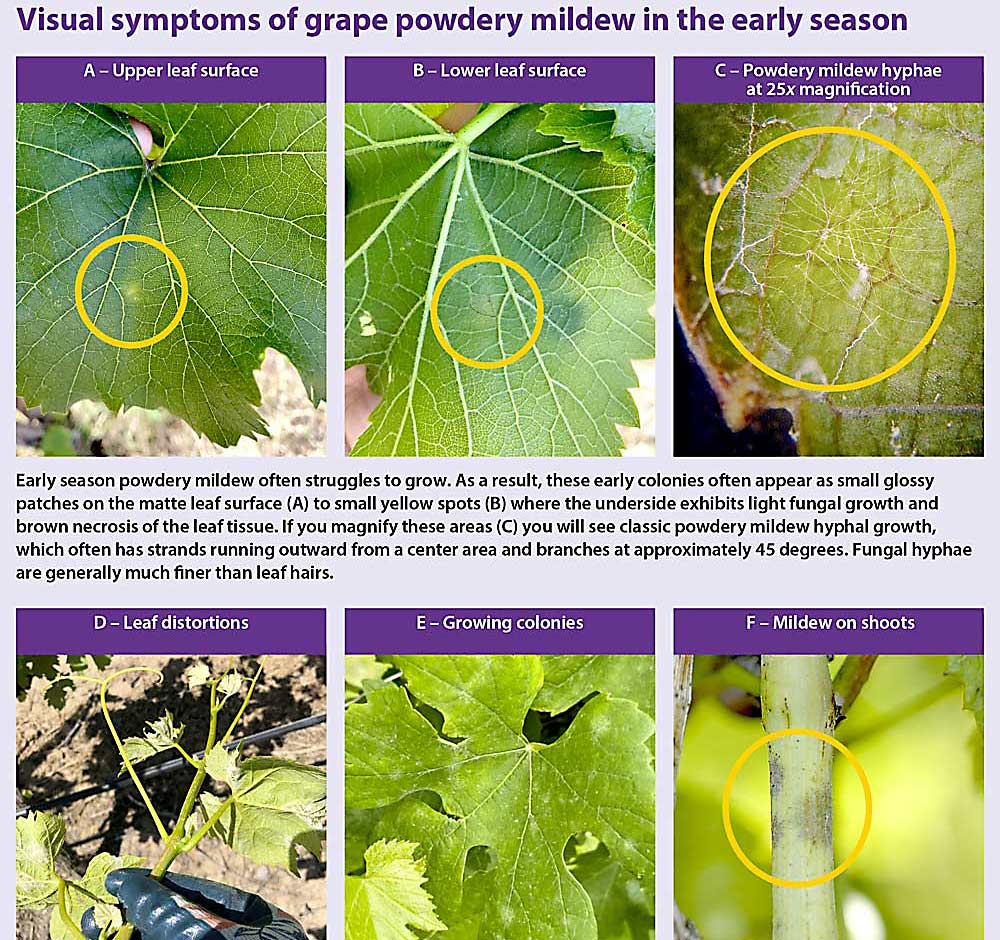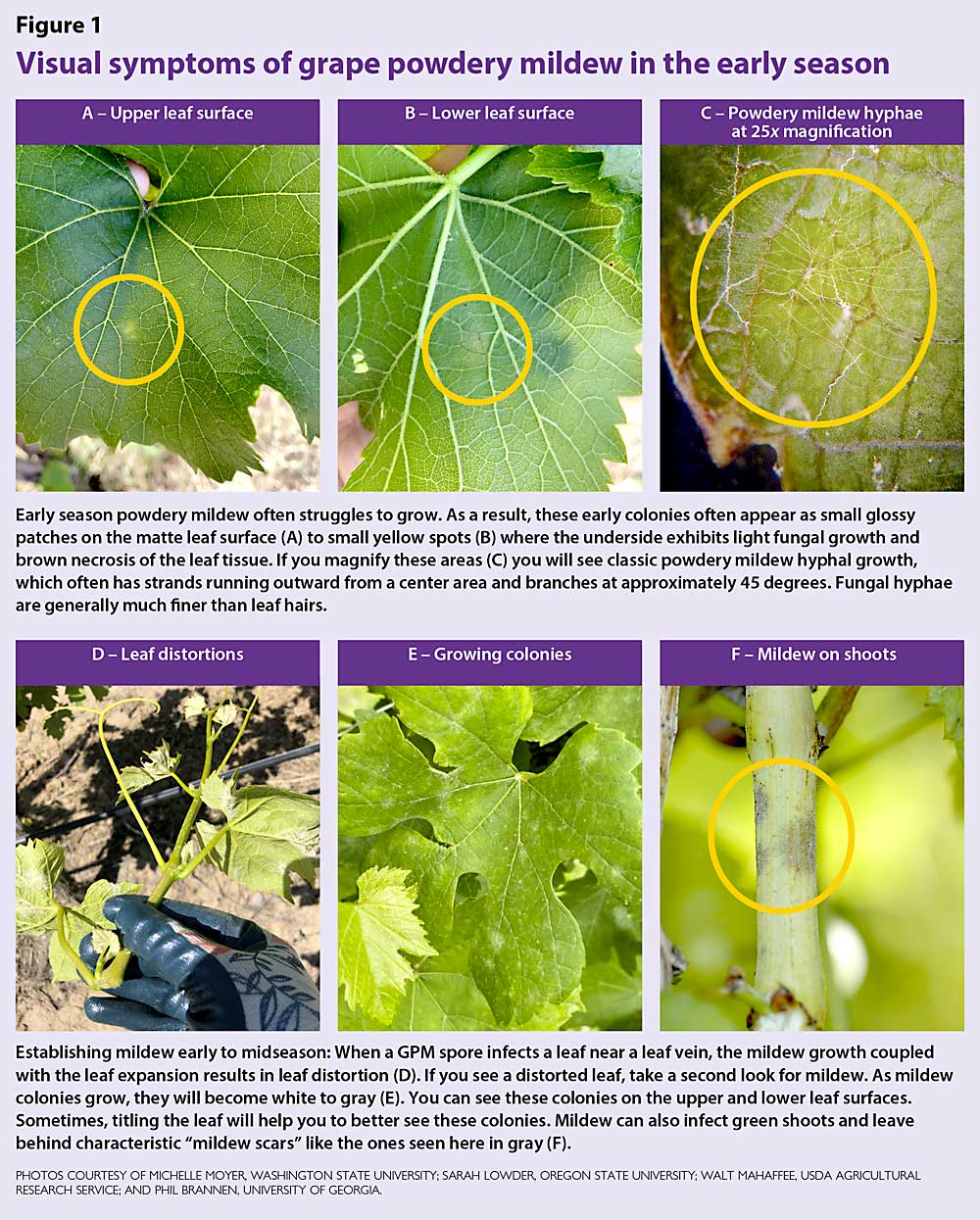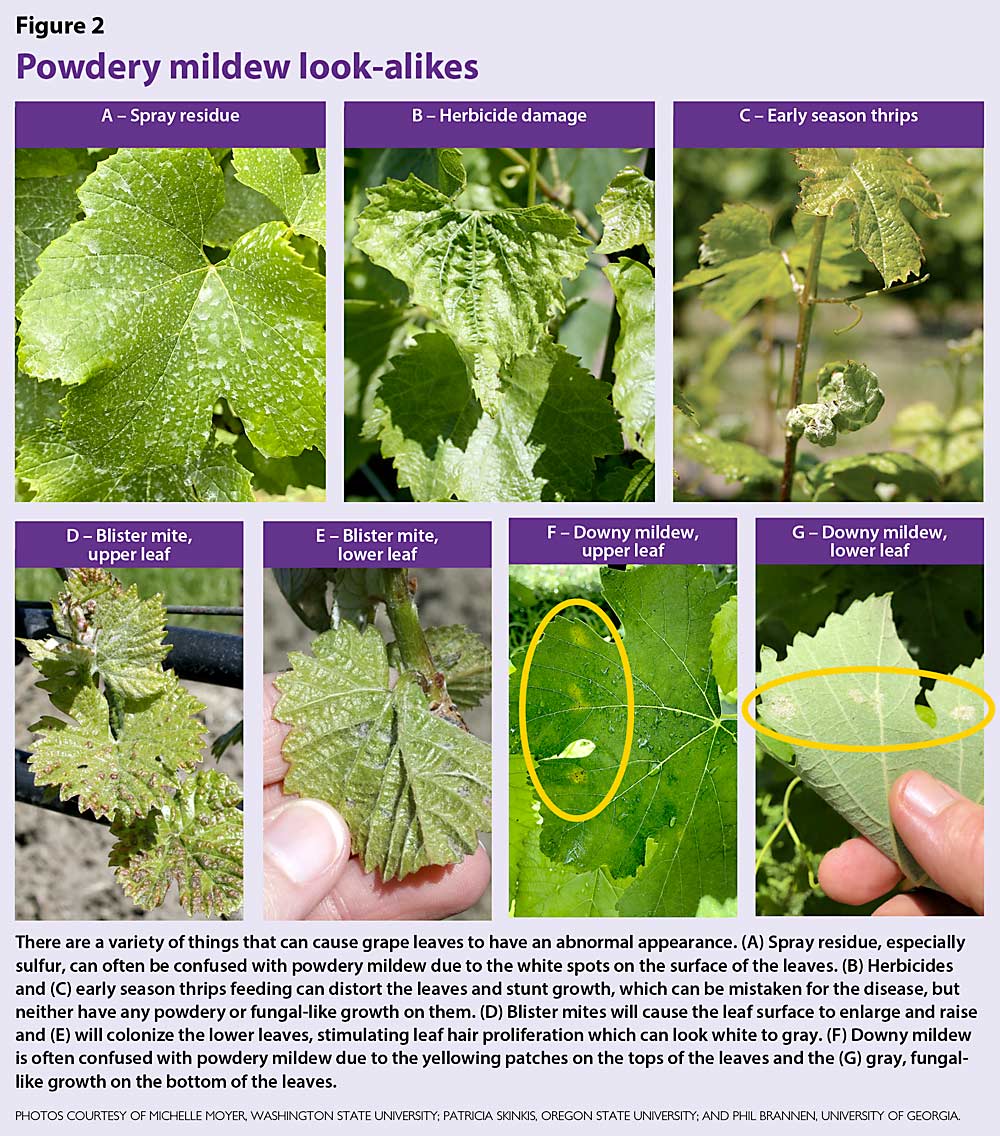
Grape powdery mildew (GPM) is a problem for grape growers around the world. While it is often thought of as a “late season” disease, the best way to manage it is to focus control efforts early in the growing season. Early-season scouting can help avoid control program failures by identifying high disease pressure seasons, poor spray coverage or timing, or fungicide resistance before it is too late for the crop.

When to start scouting
In the early season, one of the biggest challenges can be identifying mildew infections on leaves with a high density of leaf hairs. While leaf hair density is variety-specific, typically younger leaves (shoot tips) will have a higher leaf hair density than older leaves (shoot base). This is due to leaf area expansion as the leaves develop. Waiting to start scouting until 6 inches of shoot growth will allow some time for older leaves to expand, thus making it easier to distinguish the mildew’s hyphae from leaf hairs before disease can reach levels that can’t be managed.
Where to scout
On the vineyard scale, start in your “hot spots.” This is where disease is routinely more severe or typically first observed each year. Consequently, it may be good to scout in vineyard areas that are upwind to these locations. Other areas to focus on include where there is naturally high vigor, areas with prolonged morning or afternoon shade (e.g., close to a tree line), or where there are untreated vines (e.g., feral, abandoned, decorative) near the production blocks. In addition, when an outbreak is a result of poor spray practices, GPM might also be concentrated in rows that are skipped during sprays, in canopy (or sucker) locations where nozzles may not have been directed, or on end vines where sprayers may have been prematurely shut off.
On the vine scale, since the GPM fungus mostly overwinters in bark, scouting the basal leaves near the cordon or trunk is a good place to start. As the canopy grows, examine leaves that may be shaded in the canopy interior. Not only are these leaves growing in a more favorable microclimate (low ultraviolet light, higher humidity), they are also more likely to be the leaves that are missed during fungicide applications.
What to look for
Early in the growing season, powdery mildew colonies may not look like the characteristic white mildew often shown in scouting guides. This is because the fungus often does not grow well in the early season due to high light exposure and cooler nighttime temperatures. Colonies can be small and appear with light-yellow discoloration on a leaf (Figure 1A). In some cases, these early infections may not cause yellowing, but can cause a “glossy” spot on the normally matte upper leaf surface. You can see these glossy spots by moving the leaf back and forth in the light and observing the surface for changes in sheen. If you flip that leaf over, you might see brown discoloration where both the mildew colony and leaf struggle to survive (Figure 1B). None of these symptoms are necessarily diagnostic for mildew, so magnify these areas and see if you can observe the characteristic branching and growth of the powdery mildew fungus hyphae (Figure 1C). These hyphae are generally straighter and more translucent than grape leaf hairs.
Leaves infected early in their development can become distorted. Turn over any distorted leaves you see to check for powdery mildew on the leaf underside (Figure 1D). As the mildew colony develops, the additional hyphae that grow during spore development will cause the colony to become characteristically white to gray (Figure 1E). In direct sunlight, these spots might be difficult to see, so moving the leaf to view the surface at different angles also assists in seeing these colonies.
Green shoots can also be infected by the mildew fungus (Figure 1F), resulting in gray “scars” that are highly visible when scouting. Since grapevines have indeterminant growth, where these scars appear on the shoot can be an indication of when infection occurred. Scars at the shoot base indicate there was active mildew early in the season; scars near the shoot tips are indicative of later-season infections.
Things that look like GPM

There are a lot of things that look very similar to powdery mildew. Spray residue or water spots from rain can leave what looks like white spots on a leaf (Figure 2A). Contact herbicides (Figure 2B) can stunt growth and cause leaf distortion that may look like the beginning of an infection. Insect damage, such as early-season thrips infestations, can also be confused for powdery mildew infections (Figure 2C). The grape blister mite (erineum mite) develops colonies that resemble fungal mycelium (Figure 2E) on the undersides of leaves, though they are always accompanied by puckered “blisters” on the tops of the leaves (Figure 2D). Other grape diseases, such as downy mildew, can also produce yellowing spots on the upper leaf surface (Figure 2F) that can look like early-season diffuse mildew colonies, but they will also have white to grey growth on the underside of the leaf (Figure 2G).
To be confident that you have GPM, use a hand lens with at least 10x (preferably 30x or greater) magnification to look for the characteristic mycelium growth pattern (Figure 1C) on suspect areas.
Early-season scouting can improve your management program
GPM is a disease that is best managed with an approach that focuses on prevention rather than catch-up. Early-season scouting can allow you to identify potential lapses in program efficacy and allow for early adoption of additional cultural practices or adjustments in spray timing or product selection, to stop GPM outbreaks before they become widespread. •
—by Sarah Lowder and Brooke Warres
Sarah Lowder is a graduate research assistant at Oregon State University, and Brooke Warres is a graduate research assistant at the University of Georgia. This article was written as a part of efforts associated with the project funded by United States Department of Agriculture — National Institute for Food and Agriculture — Specialty Crop Research Initiative Award No. 2018-03375 titled “FRAME: Fungicide Resistance Assessment, Mitigation and Extension Network for Wine, Table, and Raisin Grapes.” The authors would also like to thank Michelle Moyer, Washington State University; Walt Mahaffee, USDA Agricultural Research Service; and Phil Brannen, University of Georgia for their review.
The Link LonkFebruary 01, 2021 at 10:14PM
https://ift.tt/3akg8GO
Early-season scouting for grape powdery mildew - Good Fruit Grower
https://ift.tt/3eO3jWb
Grape

No comments:
Post a Comment